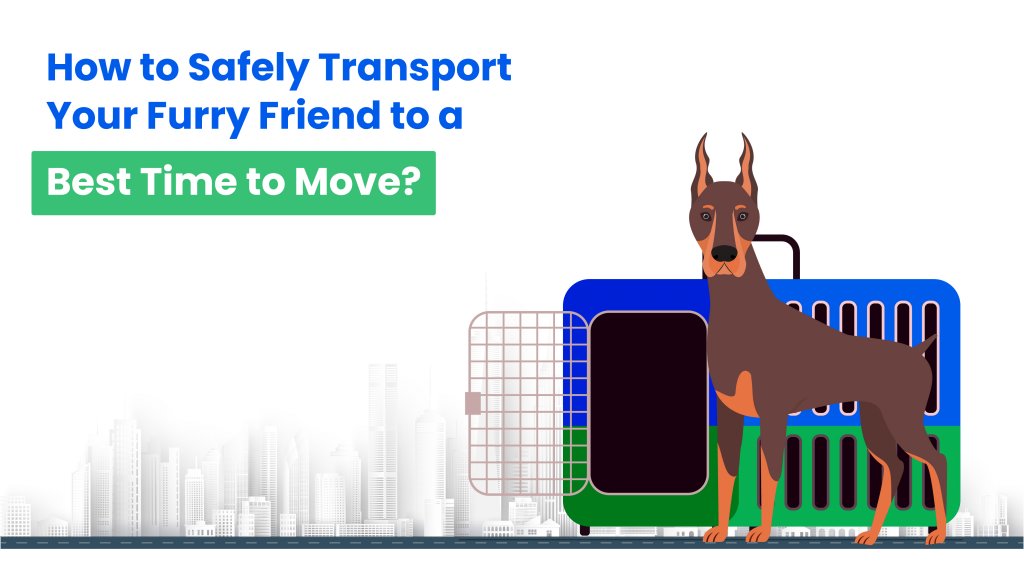Pet relocation is the most tricky aspect while moving. It is a challenge that your furry friend needs to tackle safely and delightfully. Pet relocation raises a lot of queries, worries, and confusion in your mind. Hence, here is a five-minute read that can take you toward a clear roadmap for transporting your pet.

How to Safely Manage Pet Relocation?
1. Pre moving warm-up
Hey, before the ‘moving day,’ here are a few things that are best-taken care of before you sail off to your new destination-
a) A visit to the veterinarian
Moving consultation: Make sure to receive a green light from a veterinarian about the relocation distance and process. A check of its psychological state can help you make relocation more comfortable. Get a clean sheet about the physical condition of your pet before moving. Obtaining clear medical reports can help you during hiring movers and booking tickets for your pet relocation. If your pet is on any medications, it’s better to wait until the course is over and obtain full clearance for the move.
b) Vaccination and certification
Getting your pet vaccinated should be a top-priority task before you move. Transit, changing surroundings, long-distance traveling, etc., might expose your pet to infectious diseases.
Ensure your pet is vaccinated against all plausible diseases before being on board to your new destination. Keep a safe and physical copy of the vaccination certificate for verification during travel and registration.
c) Destination Check
Take a step back and assess your new destination in terms of suitability for your pet buddy. Make sure you have chosen a friendly neighborhood for your pet. Try to move into pet-friendly accommodation and notify a landlord about moving in with your pet.
d) Getting your furry friend microchipped
Getting a microchip installed on your pet might startle you at first. But it’s nevertheless a reasonable precaution when moving your pet to a new neighborhood. Ideally, the chip is installed near the outer neck region of the pet. It doesn’t raise any medical complications. While the chip is readily available, it must be registered in your name and attached contact information at the National Pet Recovery Database for activation.
2. Pet transportation shopping
Shopping for pets in advance will save you from last-minute rundowns and resource crises.
a) Pet food and essentials
Ensure you have adequate pet food to sustain your pet during the move. Try listing all essentials that your pet requires so that you won’t miss out on any necessary item.
b) Pet carrier and cushions
If you are planning to relocate your pet by yourself, then buying a pet carrier is what you need for a safe move. A pet carrier provides a defensive holding for your pet that can easily be fixed in your car or moving vehicle. Keep note of the size of the carrier suitable for your pet. An adjustable carrier might be a better choice than buying a carrier that’s too small or too spacious for your pet.
c) Hiring pet relocators
How about hiring the best packers and movers in Bangalore, Pune, Delhi, etc. to relocate your pet? Regardless of the choice of movers, it is imperative to verify their experience, expertise, terms of service, and reviews before locking a deal with a pet relocator.
3. Moving day checklist
Moving day can be pretty stressful for you and your pet. Here’s what you can do to make it hassle-free for your pet.
a) Taking a weather check
Pet relocation during violent and erratic weather is not a good idea. Your pet might be frightened and uncomfortable due to the weather changes. If your pet is behaving unusually or feeling under the weather, it’s advisable to postpone the relocation. Try to choose a bright day for pet relocation.
b)Essentials kit
Your pet can survive with the help of an essential pet kit, which also simplifies transfer. It includes pet food, water, registration and vaccination certificates, toys, accessories, wipes, tissues, and everything your pet needs. Pack the pet essentials kit in a box and handover it to your pet relocator before moving.
c) Instructions to the movers
Even if you have hired pet relocators, you might feel anxious about parting with your pet. The best way to quell this worry is to convey your requests (regarding the pet) and instructions (if any) to the pet movers. This might ensure you a stress-free moving day.
d) International pet traveling and quarantine
If you are flying your pet internationally then it will require better planning and efforts. Flying your pet through an airline is subject to quarantine and certification restrictions. Check out quarantine guidelines for pet, duration, and certification as demanded by airlines
e) Flight reservations and restrictions
Each airline has different policies, seats, and restrictions for flying pets. Make sure your pet’s breed, size, and health condition are all in sync with the pet flying policies of the prospective airlines. While small pets can be placed below your seat in a pet carrier, large pets are allotted a separate section/cargo section. Booking air tickets for your pet tends to be done in advance to avoid cancellations, price hikes, inconvenience, and errors.
f) Protocols to follow at the destination
Check out restrictions on your pet breed that are in force in your destination country. Some countries have mandatory pet registration and demand vaccination against certain diseases. Once you know the rules, it will become easier to manage your pet accordingly.
g) Some dilemmas you come across while pet relocation
Decision-making while relocating pets takes a lot of work. You need to be rational and sensitive about your pet’s safety at the same time. We have listed out some common dilemmas one comes across while pet relocation.
Pet Relocators or DIY Pet Relocation: Which is Better?
This is the primary question that comes to some planning a pet relocation- Whether to take the risk and effort of pet relocation themselves or to entrust it to professional pet relocators.
The dilemma is real, but you can decide based on your situation. Suppose you are moving with a puppy or a relatively small pet that can be handled easily /moving across a small distance. In that case, it is economical to handle the pet relocation yourself.
If you are moving across the country or internationally with a large breed pet, such a relocation involves numerous paperwork and restrictions, which is better handled by professional pet relocators.
Microchip Installation: Optional or Mandatory?
The fear of microchip installation on your dear pet might lead you to compare whether it is mandatory or optional. Frankly, there is no iron-clad rule for or against microchip installation.
If your pet is too young and drifts astray often, a microchip might help you track it down quickly. If your pet is smart and old enough to find itself back home quickly, then you can keep microchip installation as an option.
Pet Sitters or Self-Handling: Which is Advisable??
Hiring pet sitters during relocation might lift the load on you and let you focus on handling relocation tasks. It might be physically and mentally better for your pet buddy. Further, pet sitters can help you maintain your pet’s schedule(eating, strolls, playing, etc.) even during relocation.
But handling the pet yourself seems irresistible: you can spend precious time with your furry friend, make sure it is comfortable, and look pretty economical too.
Pet Care After Moving
While you might have completed pet relocation, it’s time to make your pet settle down and get comfortable in the new surroundings. Keep it secure until you carefully unload and unpack all your belongings. After you unpack and settle down in your new home, it’s time to spend the time with your pet missed, during the relocation.
Taking it for strolls around the new neighborhood might make it easier to get accustomed to the new surroundings. You can find a new vet, pet cafes, and parks you can visit with your furry friend.
Bottom Line
Now you have the tips, steps, and precautions to take while moving your furry friend to your new home. Have a happy and safe pet relocation.


